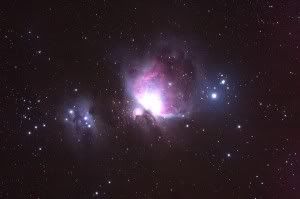As beautiful an object as you will ever see in the night sky, the Orion Nebula is a blister of glowing gas set alight by blazing new stars. This nebula is just a small part of the vast star-making machinery in our own Orion Arm of the Milky Way that offers many wondrous sights for backyard observers. The Orion Nebula is one of the finest sights in all of nature: the birth of a cluster of new stars out of a dark cloud of interstellar gas and dust.
• M42 lies in the “sword” that appears to hang off Orion’s Belt. The nebula is the middle “star” in the sword, which to the naked eye appears slightly fuzzy.
• Turn a telescope toward M42 and you will see a greyish bat-shaped mist lit up by dozens of blue-white stars. Try looking at the nebula with a range of magnifications. Start low, say at 40-50x, and work your way up. The nebulosity extends much farther than you may first think: use averted vision to glimpse its full expanse. At high magnification you’ll lose the overall shape, but you can see the fine detail in the nebula’s mottled structure and the beautiful diamond-like stars near the center that sparkle like a jar full of fireflies.
• Because of its size and brightness, the Orion Nebula looks almost as good from city skies as it does from country skies, and is a fine sight in small and large telescopes.
• In a small scope, the nebula appears greyish because its light is not bright enough to stimulate the color-sensing cone cells in your retina. In a larger telescope, you might see traces of green and red. I have never seen the color firsthand, but it must surely accentuate the beauty of this wonderful object.
• The Orion Nebula is so complex and sublime that you see new detail every time you look at it. Try not to rush when you observe this wonder. Savor it. And if you can, try to make sketches to train your eye to see more detail. This nebula is an object that, in my opinion, looks better visually than photographically.

• The particulars: M42 lies some 1,500 light years from Earth and spans about 20 light-years. Radio telescopes show the unlit gas and dust span more than 100 light-years beyond the visible nebula and contains the mass of 10,000 Suns.
• At the heart of the nebula is the multiple star system theta Orionis, also called the Trapezium, so-named because it looks like a tiny trapezoid. There are actually six stars here, though you need good seeing, a 4 inch or larger telescope, and magnification of 100x or more to resolve them all. The stars of the Trapezium, which are just 100,000 years old, have blown a bubble in the surrounding gas that gives us a view of the nebula’s inner core.
• The energy that lights up the gas and dust of the Orion nebula comes from dozens of hot new stars that have recently coalesced out of the nebula itself. Hydrogen and traces of oxygen gas absorb the blue and ultraviolet light from the stars and re-radiate red and green light at characteristic wavelengths. A UHC or OIII filter may improve the contrast in some parts of the nebula, especially for urban observers.
Just north of the main nebula, separated by a gulf of dark sky, lies the smaller companion nebula, M43. It’s also an emission nebula, lit by an embedded 8th magnitude star. And south of M42 you’ll find the 3rd-magnitude triple star iota Orionis, another fine object for a small scope.
It’s truly one of the most beautiful things you will every see.
source....
I hope to take some pictures of this myself as soon as the weather cooperates.
- Quads, hailing from Grand Marsh Observatory atop Elk Castle Hill